
A government-industry panel charged with making recommendations for creating a “micro drone” category has submitted its formal report to the FAA.
The Micro UAS Aviation Rulemaking Committee, which includes AOPA, was tasked with developing recommendations that would allow pilots of the smallest and lightest drones to safely fly over people—something that has been prohibited, limiting the usefulness of the sometimes tiny aircraft. The FAA announced April 6 that it had formally accepted the recommendations and begun the process of developing a notice of proposed rulemaking based on those recommendations.
The committee recommended establishing four categories of micro drones based on the risk of injury posed by operations over people. Each category is based on either weight or an impact energy equivalent.
“As with all GA regulations, we believe that taking a risk-based approach is the best way to ensure safety without creating unnecessarily burdensome rules that stifle aviation innovation and activity,” said AOPA Vice President of Government Affairs Melissa Rudinger, who represented AOPA on the committee. “These recommendations will help protect bystanders while allowing small drone operators to get the most from their aircraft.”
Under the recommendations, drones that weigh 250 grams or approximately half a pound or less, including any cameras or other payload and accessories, would fall under Category 1 and would face no restrictions beyond those proposed in the pending small UAS rule, FAR Part 107.
Aircraft in the remaining categories would face additional restrictions based on the likelihood that they could cause serious injury if they struck someone during their operation. Category 2 would include aircraft demonstrated to have a less than 1 percent chance of causing a serious injury while Category 3 and 4 aircraft would have a less than 30 percent chance of causing serious injury. Under the committee’s recommendations, Category 3 aircraft would be prohibited from flying over crowds or dense concentrations of people.
Category 4 aircraft also would take into account the materials and components used to determine whether they might cause collateral damage and require the pilot to have a plan in place to mitigate the risk of operating over people.
In each case, testing would be required to determine that the aircraft meets the impact energy threshold for its category, and the drone manufacturer would be required to submit a declaration to the FAA saying that its product meets standards for the applicable category. Manufacturers also would be required to label the product or packaging appropriately, and provide an operating manual. Drone pilots would be responsible for knowing what category their aircraft falls into and complying with operational limitations.
In addition to AOPA, the committee included representatives from across the drone and manned aircraft communities, including manufacturers, operators, airlines, hobby groups, and others.



